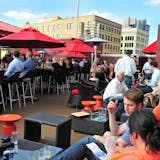Shortly after our arrival at Harry Potter World, as it is known among grade-schoolers, we passed through a brick wall with magical ease, and found ourselves standing in Diagon Alley, a secret part of London that only witches and wizards know. The buildings on either side of the street seemed to lean inward. At the end of the street towered Gringotts Bank, with a huge dragon atop, breathing fire.
My wife, Bridgit, and I walked behind our two girls, Libby and Josie, who at ages 9 and 11 were dressed in their finest wizarding robes. We passed Weasleys' Wizard Wheezes, and the entrance to Knockturn Alley. We had another destination in mind: Ollivander's Wand Shop. Our girls were there to get their wands.
Harry Potter World was a strange place to be. Officially it's called "The Wizarding World of Harry Potter," and it's part of the Orlando-based Universal Studio Theme Park. Actually, it is two separate parks grafted onto both "Universal Studios Florida" and "Islands of Adventure." These two Harry Potter Worlds are placed at the far back of the adjacent parks, and connected by a "Hogwarts Express" train.
It was strange to be there because for years now — for decades, really — Harry Potter has been a constant presence in our home. Before Bridgit and I had kids, we read the books out loud to each other. Afterward, we read them to our daughters. Together we all listened to the audio books and watched the films.
For the girls, the books were always there. When they were young, and we had no money or time for traveling, they were our means of escaping to another world. They dressed up as Hermione and Hedwig for Halloween. We had Harry Potter-themed birthday parties. In the many hours we spent turning pages together, we came to know the halls of Hogwarts and the streets of Diagon Alley as well as any other fictional world (and some real ones) that we had inhabited.
When our girls were old enough, they began reading the books themselves. So once they learned about the existence of Harry Potter World, it was only a matter of time before we went. We talked about it for years. They saved their money from pet-sitting and selling cookies so they could buy wands and other things. We even put our house on Airbnb to help pay for the trip. And now, here we were.
Slytherin at Hogwarts
Ollivander's was dark inside. We were early so there weren't many people. Along the wall a line was forming. We got in it and soon were led with a small group back to Ollivander's office. Inside, the wandmaker himself stood behind a desk.
He welcomed us, then walked along the crowd, stopping at our girls. He peered down at them over his spectacles.


